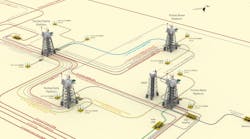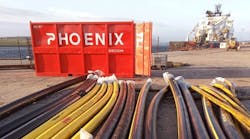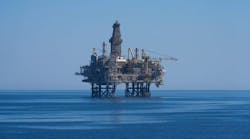Without question, the confluence of much higher natural gas prices and oil prices in the $24-30/bbl range in North American energy markets will push exploration to higher levels in North America and South America.
Oil and gas operators have wrung out the last remaining production from workovers, re-developments, and new horizons in mature and maturing fields. This activity over the past two years has dropped reserve replacement, and operators have no choice but to drill.
Canada
Canada has experienced the same surge in gas prices that has rocked the US, and Canadian drilling has responded in kind. Spending is up, and the likelihood of a hike in E&P spending over the coming year is high. Encouraged by high natural gas prices, producers seeing strong cash flow are pumping more money into exploration offshore Canada. So far, this type of investment is paying off.
Offshore seismic activity in Canada should remain on a level with the last two years, which is quite high from a historical perspective. In 1999 Petroleum Geo-Services (PGS) had four 3D vessels active through the season. Last year there were five. This year, the company will see four vessels working in this region.
Drilling is also up. The Canadian Association of Petroleum Producers (CAPP) said that there were 16,529 wells drilled onshore and offshore in 2000, and total rig utilization in February of this year reached 94%. The coming year should see continued activity.
The Nova Scotia Offshore Petroleum Board has awarded a number of tracts, some in ultra-deepwater. Husky Energy is evaluating the development of natural gas reserves in the Jeanne d'Arc Basin off the southeast coast of Newfoundland. There is no shortage of investors in an area that has the appeal of a sound track record - for gas.
The only hiccup might be a boundary dispute in the northeast between Nova Scotia and Newfoundland over an area with a potential 9 Tcf of natural gas reserves. A federal arbitration panel opened hearings in March, but immediate resolution is not a foregone conclusion.
The sub-basin could be open for exploration in 2002. On the other hand, if the panel cannot reach a decision, it could take years to resolve the dispute, which could leave the area out of the E&P picture.
Alaska
Headline news in Alaska is the debate over the Arctic National Wildlife Refuge (ANWR) coastal plain. When the political wrangling is finally over, Alaskans are hoping that the US federal government will allow drilling on the ANWR. A poll of Alaskans has shown overwhelming support of environmentally responsible development.
With declining North Slope reserves, the state is interested in opening up new exploration areas. However, oil companies may not be ready to jump in. The long lead time required to build the infrastructure to support ANWR is a deterrent, particularly when ample drilling opportunities are available in many other areas that already have a developed infrastructure.
Gulf of Mexico
Drilling and production activity in the Gulf of Mexico (GOM) continues to be heavy. In the past year, drillers have moved into increasingly deeper waters, with record depths being recorded and exceeded several times. Production in water depths over 1,000 ft. has risen dramatically over the past five years.
Activity is high, and the Minerals Manage-ment Service is working to keep it high by offering royalty relief incentives to increase exploration and development in deepwater, the deep shelf (below 15,000 ft), and subsalt.
New areas are also opening up. The upcoming August lease sale may include the Doughnut Hole area of the central deep GOM. The rights to the 11,000 sq mi. area were settled by a treaty signed last June by Mexico and the US.
According to Beacon Energy, a Washington-based consulting firm, production from the federal waters of the GOM declined 1.3 Bcf/d between January 1999 and June 2000. If the US plans to boost internal gas production, a lot of activity will have to take place in the coming year.
With the current financial climate, a lot of companies are increasing exploratory activity in the gulf. Not surprisingly, the Gulf of Mexico, along with West Africa and Brazil, will see a great deal of exploration investment this coming year.
Mexico
Mexico has found itself at a crossroads. The country, under President Vicente Fox, is moving toward privatization and is working to improve its economic stature by attracting outside investment. The problem is that implementing a privatization policy is a complex undertaking and will take time. The hope is that the window of opportunity will stay open long enough for the country to capitalize on the upswing in the oil and gas industry.
E&P sectors should not be affected dramatically by the new policy right away, in part because of the many contracts signed with companies that are reworking fields and pursuing new lighter crude reserves. However, new contracts could see the appearance of different terms as the country moves its privatization platform forward.
Fox has identified the state-run Pemex and the Federal Power Utility as stumbling blocks to progress. One specific move to increase productivity was to allow gas transport through national pipelines. Common access will give competitors access to the same lines. It should also significantly increase throughput. Fox's actions are directed at removing the barriers that keep Mexico from realizing its potential as a major player in the oil and gas theater. With luck, the country will see very favorable results from Fox's ambitious plans.
Brazil
Brazil saw the drilling of 90 offshore wells last year, 27 exploratory tests and appraisals, and 63 development wells. A great deal of deepwater activity took place in 2000, and positive results from test wells coupled with encouraging data from geophysical surveys indicate that a lot more deepwater drilling should take place soon.
However, outside investors are having a different experience from Petrobras in terms of opportunities. Licensing terms are considered too stiff relative to investment opportunities elsewhere around the globe, and drilling may not reach expected levels in 2001.
Agencia Nacional do Petroleo (ANP), the Brazilian regulatory agency, may re-claim a number of joint venture agreements in the near future as their three-year contract period concludes. A lot of projects will have to be tested in order to circumvent the ANP's reclamation of these areas. If the contractually agreed-upon activity does not take place, the ANP is within its rights to regain possession of the areas and re-sell them.
In addition to the possible sale of re-claimed blocks, a bidding round for 53 oil exploration areas will be held in June, with most of the blocks in the south and central offshore sectors.
Petrobras experienced a setback in mid-March when the P-36 operating on Roncador field suffered explosion damage and eventually sank. Eleven crew members died as a result of the event. Petrobras is confident that some of the lost production can be made up by moving an available drilling-production unit to Roncador.
Trinidad
In Trinidad, success has bred success. The country's proven gas reserves for 2000 were 21.3 Tcf , with probable or possible reserves estimated at 9.4 Tcf. Exploration companies have been very successful, and the burgeoning gas market has encouraged increased investment.
An example is the late-January Petrobras Trinidad Ltd. farmout agreement submitted to Norsk Hydro AS for exploration Block 27 (1,220 sq km). The proposed deal gives Hydro half of Petroleo Brasileiro S/A's 38% stake in the deepwater acreage, where water depths range from 700-1,200 meters. Following a 3D seismic survey of the block, the first of two exploration wells, which were awarded in 1998, is scheduled to be spudded in August or September.
Late last year, the country opened up a new gas province when it approved the Hibiscus, Poinsettia, and Chaconia fields, operated by BG. The fields hold total proved and probable reserves of 2.4 tcf. Rising gas prices in the US have industries considering relocating or expanding in Trinidad, where companies have conducted successful gas-based projects.
Argentina
For the past year and a half, high angle drilling has been underway along the Argen-tinean coast, but to date there have been no sizable discoveries. Although there is geological evidence that the area contains good prospects, so far, no one has found them in strongly commercial volumes.
Argentina is working to attract investors. The company has made reforms in the gas sector, but activity has not been high. With the state-owned Repsol-YPF imposing prices, there is still too much market manipulation to draw companies into the country.
Falkland Islands
Activity offshore the Falklands has been less than noteworthy. In 1999, there was no drilling activity, and 2000 was fairly inactive. Companies aren't exactly champing at the bit to get into the area. Although the geology indicates there may be reserves on the Falklands plateau, so far, none of the companies drilling there has determined where. The country is going to have a tough time enticing exploration companies with so many other promising prospects out there.
Venezuela
Poorly considered appointments by Venezuelan President Hugo Chavez have wreaked havoc in state-owned Petróleos de Venezuela, S.A. (PDVSA). Activity last year was meager, and PDVSA is predicting even less activity for 2001, an embarrassing decline in a booming world market. Even if new (and wiser) appointments are made, it is not likely that the country will make up lost ground very quickly.
Other limitations for investors are a result of potential changes brought about by a new hydrocarbon law that raises questions about LNG taxes, municipal taxes, and the possibility of forced participation in what could be unprofitable domestic oil and gas projects. In the near future, it appears that politics and legislation will hobble E&P.
Colombia
The Colombian government made a decision recently to cut back on its share of the profits in smaller E&P projects, and the results so far have encouraged greater upstream investment. President Andrés Pastrana's official announcement early in the year of the Colombia Plan should also encourage investment.
The plan officially states the country's intention to work with the US to modernize legal and military institutions, strengthen the economy, and crack down on drug trafficking. Investors who shied away from Colombia in the past should be encouraged by the new plan when there is evidence that it will work.
Cuba
Cuba is expected to lease 59 blocks totaling about 2,000 sq km in the eastern Gulf of Mexico and Western Straits of Florida in water depths of 2,000-4,000 meters.
Petrobras has plans to drill one offshore test well in 2001, and positive results will spur more interest. However, for the foreseeable future, Cuba will have a negligible role in the global oil and gas theater. As long as US sanctions are in place, US companies will not get involved.







